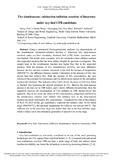JavaScript is disabled for your browser. Some features of this site may not work without it.
| dc.contributor.author | Chen, Liang | |
| dc.contributor.author | Wang, Chunbo | |
| dc.contributor.author | Yan, Guangjing | |
| dc.contributor.author | Zhao, Fan | |
| dc.contributor.author | Anthony, Edward J. | |
| dc.date.accessioned | 2018-10-24T14:04:43Z | |
| dc.date.available | 2018-10-24T14:04:43Z | |
| dc.date.issued | 2018-10-16 | |
| dc.identifier.citation | Liang Chen, Chunbo Wang, Guangjing Yan, et al., The simultaneous calcination/sulfation reaction of limestone under oxy-fuel CFB conditions. Fuel, Volume 237, 1 February 2019, Pages 812-822 | en_UK |
| dc.identifier.issn | 0016-2361 | |
| dc.identifier.uri | https://doi.org/10.1016/j.fuel.2018.10.060 | |
| dc.identifier.uri | http://dspace.lib.cranfield.ac.uk/handle/1826/13563 | |
| dc.description.abstract | Using a customized thermogravimetric analyzer, the characteristics of the simultaneous calcination/sulfation reaction of limestone (the simultaneous reaction) under oxy-fuel circulating fluidized bed (CFB) boiler conditions were investigated. The results were compared with the calcination-then-sulfation reaction (the sequential reaction) that has been widely adopted by previous investigators. The sample mass in the simultaneous reaction was higher than that in the sequential reaction. With the increase of SO2 concentration (0–0.9%), the mass difference between the two reaction scenarios increased; while with the increase of temperature (890–950 °C), the difference became smaller. Calcination in the presence of SO2 was slower than that without SO2. With the increase of SO2 concentration, the pore volume of the calcined CaO decreased, and the effectiveness factors of the calcination reaction also declined. This indicates when CaSO4 forms, the pores in CaO were filled or blocked, thus increasing the internal resistance to CO2. Because the simultaneous process is the real one in CFB boilers, and it shows different characteristics from the sequential reaction, all investigations of CaO sulfation in CFB should follow this approach. Also in this work, the effects of SO2 concentration, temperature and H2O on the simultaneous reaction were studied. The sulfation ratio in the simultaneous reaction increased with higher SO2 concentration. Compared with that in the absence of H2O, 8% H2O in flue gas significantly improved sulfation. In the tested range (890–950 °C), the optimum temperature for sulfation was around 890 °C. The sulfation rate in the mass-loss stage was higher than that in the fast sulfation stage, which is likely due to the continuous generation of nascent CaO in this stage. | en_UK |
| dc.language.iso | en | en_UK |
| dc.publisher | Elsevier | en_UK |
| dc.rights | Attribution-NonCommercial-NoDerivatives 4.0 International | * |
| dc.rights.uri | http://creativecommons.org/licenses/by-nc-nd/4.0/ | * |
| dc.subject | Oxy-fuel | en_UK |
| dc.subject | Calcination | en_UK |
| dc.subject | Sulfation | en_UK |
| dc.subject | Simultaneous reaction | en_UK |
| dc.subject | Limestone | en_UK |
| dc.subject | CFB | en_UK |
| dc.title | The simultaneous calcination/sulfation reaction of limestone under oxy-fuel CFB conditions | en_UK |
| dc.type | Article | en_UK |
Files in this item
The following license files are associated with this item:
This item appears in the following Collection(s)
-
Staff publications (SWEE) [2805]

